2010 PEUGEOT 807 ESP
[x] Cancel search: ESPPage 89 of 237
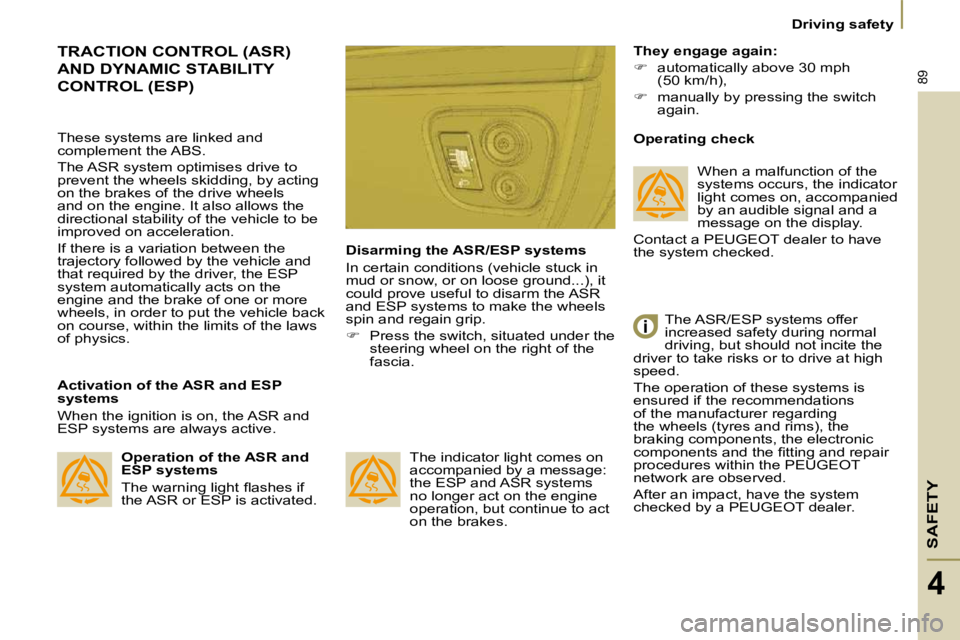
SAFETY
89
Driving safety
4
TRACTION CONTROL (ASR)
AND DYNAMIC STABILITY
CONTROL (ESP)
Activation of the ASR and ESP
systems
When the ignition is on, the ASR and
ESP systems are always active. Disarming the ASR/ESP systems
In certain conditions (vehicle stuck in
mud or snow, or on loose ground...), it
could prove useful to disarm the ASR
and ESP systems to make the wheels
spin and regain grip.
� Press the switch, situated under the
steering wheel on the right of the
fascia.
The indicator light comes on
accompanied by a message:
the ESP and ASR systems
no longer act on the engine
operation, but continue to act
on the brakes. Operating check
The ASR/ESP systems offer
increased safety during normal
driving, but should not incite the
driver to take risks or to drive at high
speed.
The operation of these systems is
ensured if the recommendations
of the manufacturer regarding
the wheels (tyres and rims), the
braking components, the electronic
�c�o�m�p�o�n�e�n�t�s� �a�n�d� �t�h�e� �fi� �t�t�i�n�g� �a�n�d� �r�e�p�a�i�r�
procedures within the PEUGEOT
network are observed.
After an impact, have the system
checked by a PEUGEOT dealer.
They engage again:
� automatically above 30 mph
(50 km/h),
� manually by pressing the switch
again.
Operation of the ASR and
ESP systems
� �T�h�e� �w�a�r�n�i�n�g� �l�i�g�h�t� �fl� �a�s�h�e�s� �i�f�
the ASR or ESP is activated.
These systems are linked and
complement the ABS.
The ASR system optimises drive to
prevent the wheels skidding, by acting
on the brakes of the drive wheels
and on the engine. It also allows the
directional stability of the vehicle to be
improved on acceleration.
If there is a variation between the
trajectory followed by the vehicle and
that required by the driver, the ESP
system automatically acts on the
engine and the brake of one or more
wheels, in order to put the vehicle back
on course, within the limits of the laws
of physics.
When a malfunction of the
systems occurs, the indicator
light comes on, accompanied
by an audible signal and a
message on the display.
Contact a PEUGEOT dealer to have
the system checked.
Page 90 of 237
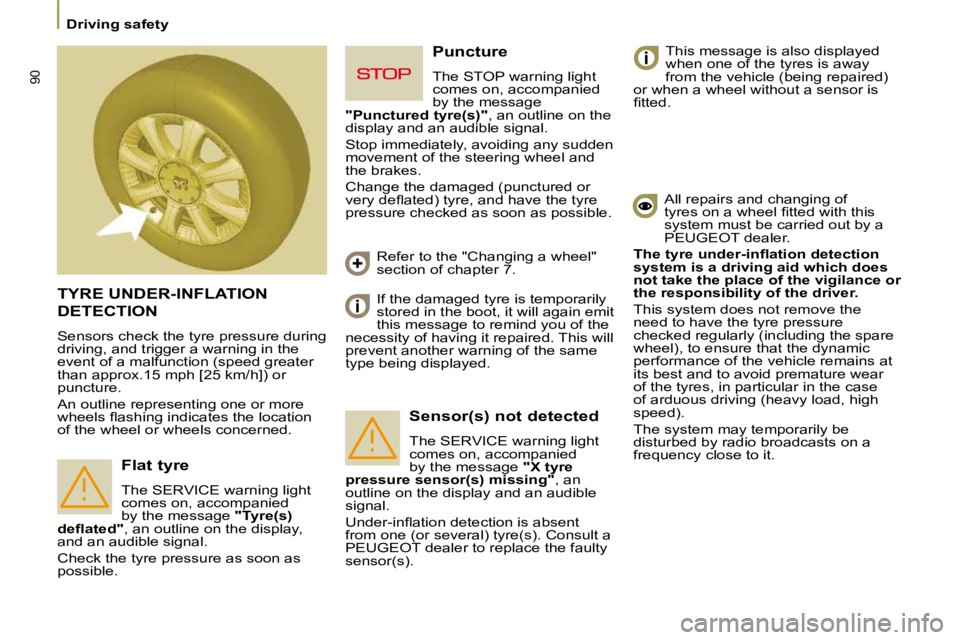
90
Driving safety
TYRE UNDER-INFLATION
DETECTION
Sensors check the tyre pressure during
driving, and trigger a warning in the
event of a malfunction (speed greater
than approx.15 mph [25 km/h]) or
puncture.
An outline representing one or more
�w�h�e�e�l�s� �fl� �a�s�h�i�n�g� �i�n�d�i�c�a�t�e�s� �t�h�e� �l�o�c�a�t�i�o�n�
of the wheel or wheels concerned. Flat tyre
The SERVICE warning light
comes on, accompanied
by the message "Tyre(s)
�d�e�fl� �a�t�e�d�" , an outline on the display,
and an audible signal.
Check the tyre pressure as soon as
possible. If the damaged tyre is temporarily
stored in the boot, it will again emit
this message to remind you of the
necessity of having it repaired. This will
prevent another warning of the same
type being displayed.
Sensor(s) not detected
The SERVICE warning light
comes on, accompanied
by the message "X tyre
pressure sensor(s) missing" , an
outline on the display and an audible
signal.
� �U�n�d�e�r�-�i�n�fl� �a�t�i�o�n� �d�e�t�e�c�t�i�o�n� �i�s� �a�b�s�e�n�t�
from one (or several) tyre(s). Consult a
PEUGEOT dealer to replace the faulty
sensor(s). This message is also displayed
when one of the tyres is away
from the vehicle (being repaired)
or when a wheel without a sensor is
�fi� �t�t�e�d�.�
All repairs and changing of
�t�y�r�e�s� �o�n� �a� �w�h�e�e�l� �fi� �t�t�e�d� �w�i�t�h� �t�h�i�s�
system must be carried out by a
PEUGEOT dealer.
�T�h�e� �t�y�r�e� �u�n�d�e�r�-�i�n�fl� �a�t�i�o�n� �d�e�t�e�c�t�i�o�n�
system is a driving aid which does
not take the place of the vigilance or
the responsibility of the driver.
This system does not remove the
need to have the tyre pressure
checked regularly (including the spare
wheel), to ensure that the dynamic
performance of the vehicle remains at
its best and to avoid premature wear
of the tyres, in particular in the case
of arduous driving (heavy load, high
speed).
The system may temporarily be
disturbed by radio broadcasts on a
frequency close to it.
Puncture
The STOP warning light
comes on, accompanied
by the message
"Punctured tyre(s)" , an outline on the
display and an audible signal.
Stop immediately, avoiding any sudden
movement of the steering wheel and
the brakes.
Change the damaged (punctured or
�v�e�r�y� �d�e�fl� �a�t�e�d�)� �t�y�r�e�,� �a�n�d� �h�a�v�e� �t�h�e� �t�y�r�e�
pressure checked as soon as possible.
Refer to the "Changing a wheel"
section of chapter 7.
Page 98 of 237
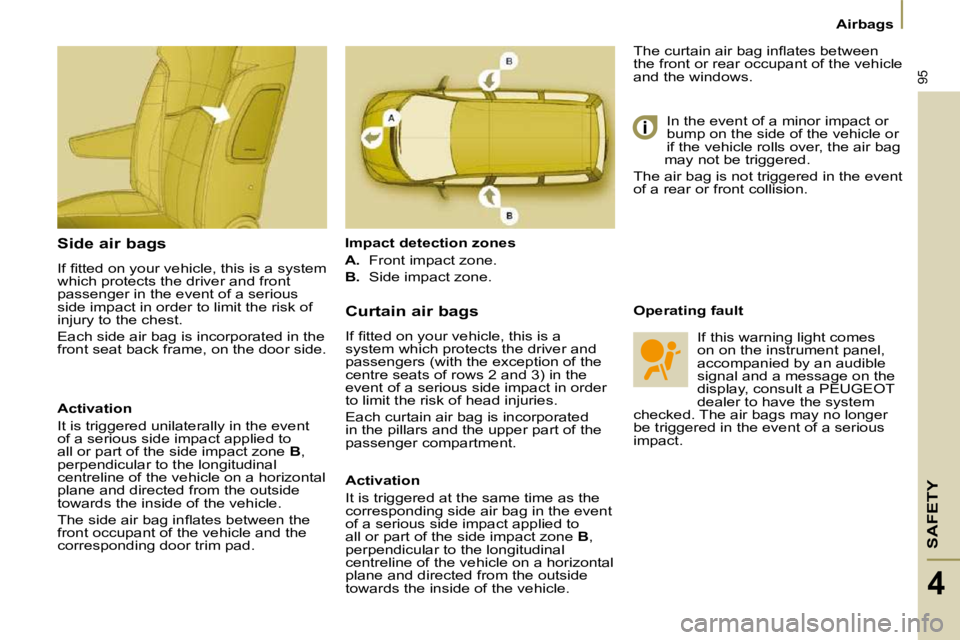
SAFETY
95
Airbags
4
Side air bags
� �I�f� �fi� �t�t�e�d� �o�n� �y�o�u�r� �v�e�h�i�c�l�e�,� �t�h�i�s� �i�s� �a� �s�y�s�t�e�m�
which protects the driver and front
passenger in the event of a serious
side impact in order to limit the risk of
injury to the chest.
Each side air bag is incorporated in the
front seat back frame, on the door side. � �T�h�e� �c�u�r�t�a�i�n� �a�i�r� �b�a�g� �i�n�fl� �a�t�e�s� �b�e�t�w�e�e�n�
the front or rear occupant of the vehicle
and the windows.
Impact detection zones
A. Front impact zone.
B. Side impact zone. In the event of a minor impact or
bump on the side of the vehicle or
if the vehicle rolls over, the air bag
may not be triggered.
The air bag is not triggered in the event
of a rear or front collision.
Operating fault
Curtain air bags
� �I�f� �fi� �t�t�e�d� �o�n� �y�o�u�r� �v�e�h�i�c�l�e�,� �t�h�i�s� �i�s� �a�
system which protects the driver and
passengers (with the exception of the
centre seats of rows 2 and 3) in the
event of a serious side impact in order
to limit the risk of head injuries.
Each curtain air bag is incorporated
in the pillars and the upper part of the
passenger compartment.
Activation
It is triggered unilaterally in the event
of a serious side impact applied to
all or part of the side impact zone
B ,
perpendicular to the longitudinal
centreline of the vehicle on a horizontal
plane and directed from the outside
towards the inside of the vehicle.
� �T�h�e� �s�i�d�e� �a�i�r� �b�a�g� �i�n�fl� �a�t�e�s� �b�e�t�w�e�e�n� �t�h�e�
front occupant of the vehicle and the
corresponding door trim pad. Activation
It is triggered at the same time as the
corresponding side air bag in the event
of a serious side impact applied to
all or part of the side impact zone
B ,
perpendicular to the longitudinal
centreline of the vehicle on a horizontal
plane and directed from the outside
towards the inside of the vehicle. If this warning light comes
on on the instrument panel,
accompanied by an audible
signal and a message on the
display, consult a PEUGEOT
dealer to have the system
checked. The air bags may no longer
be triggered in the event of a serious
impact.
Page 117 of 237

115
Checks
CHECKS
6
CHECKS
To check the main levels
and certain components,
in accordance with the
manufacturer’s servicing schedule,
refer to the pages of the Maintenance
and Warranty Guide which correspond
to your vehicle’s engine.
Only use products recommended
by PEUGEOT or products
of equivalent quality and
�s�p�e�c�i�fi� �c�a�t�i�o�n�.�
In order to optimise the operation
of units as important as the braking
system, PEUGEOT selects and offers
�s�p�e�c�i�fi� �c� �p�r�o�d�u�c�t�s�.�
In order to avoid damaging the
electrical units, high pressure washing
to clean the engine compartment is
strictly prohibited.
Oil filter
� �C�h�a�n�g�e� �t�h�e� �fi� �l�t�e�r� �r�e�g�u�l�a�r�l�y�,� �i�n�
accordance with the servicing
schedule. Refer to the servicing booklet to
�fi� �n�d� �o�u�t� �t�h�e� �r�e�p�l�a�c�e�m�e�n�t� �i�n�t�e�r�v�a�l�
for these components.
Depending on the environment (dusty
atmosphere...) and the use of the
vehicle (urban driving...), change them
twice as often if necessary.
Refer to the "Under the bonnet" section
of chapter 6. Particle emission filter (Diesel)
It is imperative that particle emission
�fi� �l�t�e�r� �m�a�i�n�t�e�n�a�n�c�e� �i�s� �c�a�r�r�i�e�d� �o�u�t� �b�y� �a�
PEUGEOT dealer.
On acceleration after the vehicle has
been running for a prolonged period
at very low speed or at idle, you may,
in exceptional circumstances, notice
the emission of water vapour at the
exhaust. This water vapour does not
have any adverse effect on vehicle
handling or the environment.
Battery
At the start of winter, have your battery
checked by a PEUGEOT dealer.
Brake pads
Brake pad wear depends on the style
of driving, in particular for vehicles
which are used in town, over short
distances. It may be necessary to
check the thickness of the pads, even
between services.
Unless there is a leak on the circuit, a
�d�r�o�p� �i�n� �t�h�e� �b�r�a�k�e� �fl� �u�i�d� �l�e�v�e�l� �i�n�d�i�c�a�t�e�s�
that the brake pads are worn.
Brake disc/drum wear status
For any information relating to
checking the brake disc/drum wear
status, contact a PEUGEOT dealer.
Handbrake
Where the handbrake travel is too
great or there is a reduction in the
performance of the system, the
handbrake should be adjusted, even
between services.
Have the system checked by a
PEUGEOT dealer. Carbon filter and passenger
compartment filter
� �T�h�e� �c�a�r�b�o�n� �fi� �l�t�e�r� �p�e�r�m�i�t�s� �c�o�n�t�i�n�u�o�u�s�
�a�n�d� �e�f�f�e�c�t�i�v�e� �fi� �l�t�e�r�i�n�g� �o�f� �d�u�s�t�.�
� �I�f� �t�h�e� �p�a�s�s�e�n�g�e�r� �c�o�m�p�a�r�t�m�e�n�t� �fi� �l�t�e�r�
becomes clogged, this may reduce
the performance of the air conditioning
system and generate unpleasant
odours.
We recommend the use of a combined
�p�a�s�s�e�n�g�e�r� �c�o�m�p�a�r�t�m�e�n�t� �fi� �l�t�e�r�.� �B�y�
means of its second special active
�fi� �l�t�e�r�,� �i�t� �c�o�n�t�r�i�b�u�t�e�s� �t�o� �t�h�e� �p�u�r�i�fi� �c�a�t�i�o�n�
of the air breathed by the occupants
and to the cleanness of the passenger
compartment (reduction of allergic
symptoms, unpleasant odours and
greasy deposits).
Manual gearbox
Have the level checked in accordance with
the manufacturer’s servicing schedule.
Page 123 of 237
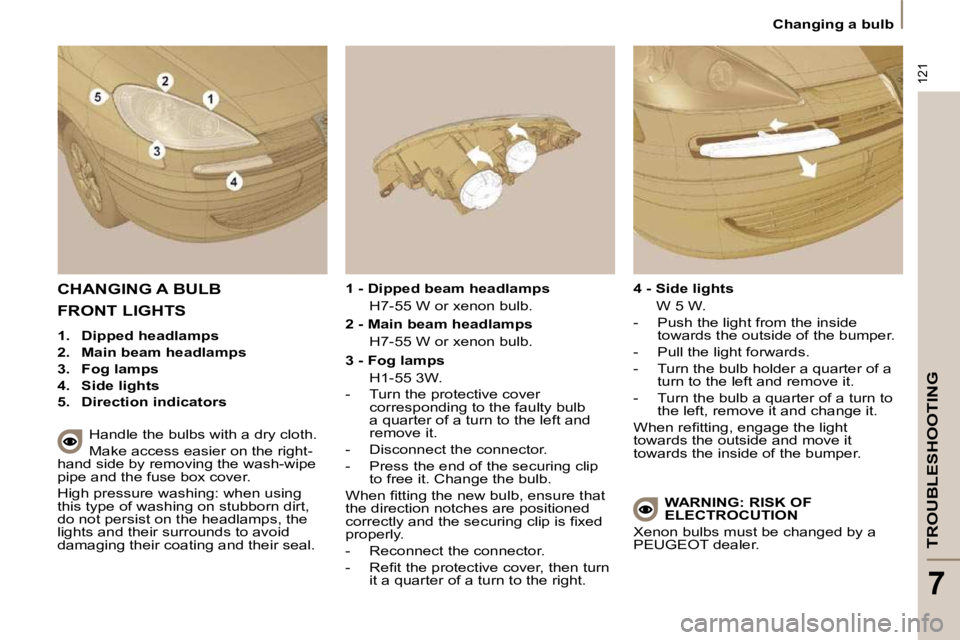
121
TROUBLESHOOTING
7
Changing a bulb
CHANGING A BULB
Handle the bulbs with a dry cloth.
Make access easier on the right-
hand side by removing the wash-wipe
�p�i�p�e� �a�n�d� �t�h�e� �f�u�s�e� �b�o�x� �c�o�v�e�r�.�
High pressure washing: when using
this type of washing on stubborn dirt,
do not persist on the headlamps, the
lights and their surrounds to avoid
damaging their coating and their seal. 2 - Main beam headlamps
� � �H�7�-�5�5� �W� �o�r� �x�e�n�o�n� �b�u�l�b�.� �
- Turn the protective cover
corresponding to the faulty bulb
a quarter of a turn to the left and
remove it.
- Disconnect the connector.
- Press the end of the securing clip to free it. Change the bulb.
� �W�h�e�n� �fi� �t�t�i�n�g� �t�h�e� �n�e�w� �b�u�l�b�,� �e�n�s�u�r�e� �t�h�a�t�
the direction notches are positioned
�c�o�r�r�e�c�t�l�y� �a�n�d� �t�h�e� �s�e�c�u�r�i�n�g� �c�l�i�p� �i�s� �fi� �x�e�d�
properly.
- Reconnect the connector.
� � �-� � �R�e�fi� �t� �t�h�e� �p�r�o�t�e�c�t�i�v�e� �c�o�v�e�r�,� �t�h�e�n� �t�u�r�n� it a quarter of a turn to the right.
3 - Fog lamps
H1-55 3W.
FRONT LIGHTS
1. Dipped headlamps
2. Main beam headlamps
3. Fog lamps
4. Side lights
5. Direction indicators 1 - Dipped beam headlamps
� � �H�7�-�5�5� �W� �o�r� �x�e�n�o�n� �b�u�l�b�.� �
4 - Side lights
W 5 W.
- Push the light from the inside towards the outside of the bumper.
- Pull the light forwards.
- Turn the bulb holder a quarter of a turn to the left and remove it.
- Turn the bulb a quarter of a turn to the left, remove it and change it.
� �W�h�e�n� �r�e�fi� �t�t�i�n�g�,� �e�n�g�a�g�e� �t�h�e� �l�i�g�h�t�
towards the outside and move it
towards the inside of the bumper.
WARNING: RISK OF
ELECTROCUTION
Xenon bulbs must be changed by a
PEUGEOT dealer.
Page 127 of 237
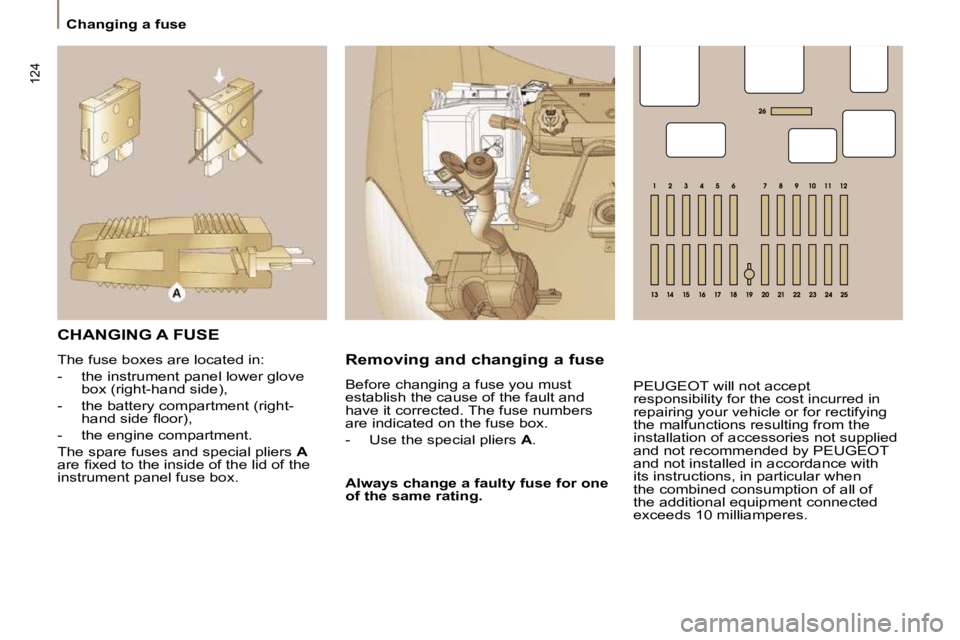
124
Changing a fuse
CHANGING A FUSE
� �T�h�e� �f�u�s�e� �b�o�x�e�s� �a�r�e� �l�o�c�a�t�e�d� �i�n�:�
- the instrument panel lower glove �b�o�x� �(�r�i�g�h�t�-�h�a�n�d� �s�i�d�e�)�,�
- the battery compartment (right- �h�a�n�d� �s�i�d�e� �fl� �o�o�r�)�,�
- the engine compartment.
The spare fuses and special pliers A
�a�r�e� �fi� �x�e�d� �t�o� �t�h�e� �i�n�s�i�d�e� �o�f� �t�h�e� �l�i�d� �o�f� �t�h�e�
�i�n�s�t�r�u�m�e�n�t� �p�a�n�e�l� �f�u�s�e� �b�o�x�.� Before changing a fuse you must
establish the cause of the fault and
have it corrected. The fuse numbers
�a�r�e� �i�n�d�i�c�a�t�e�d� �o�n� �t�h�e� �f�u�s�e� �b�o�x�.�
- Use the special pliers
A .
Always change a faulty fuse for one
of the same rating.
Removing and changing a fuse
PEUGEOT will not accept
responsibility for the cost incurred in
repairing your vehicle or for rectifying
the malfunctions resulting from the
installation of accessories not supplied
and not recommended by PEUGEOT
and not installed in accordance with
its instructions, in particular when
the combined consumption of all of
the additional equipment connected
�e�x�c�e�e�d�s� �1�0� �m�i�l�l�i�a�m�p�e�r�e�s�.�
Page 128 of 237
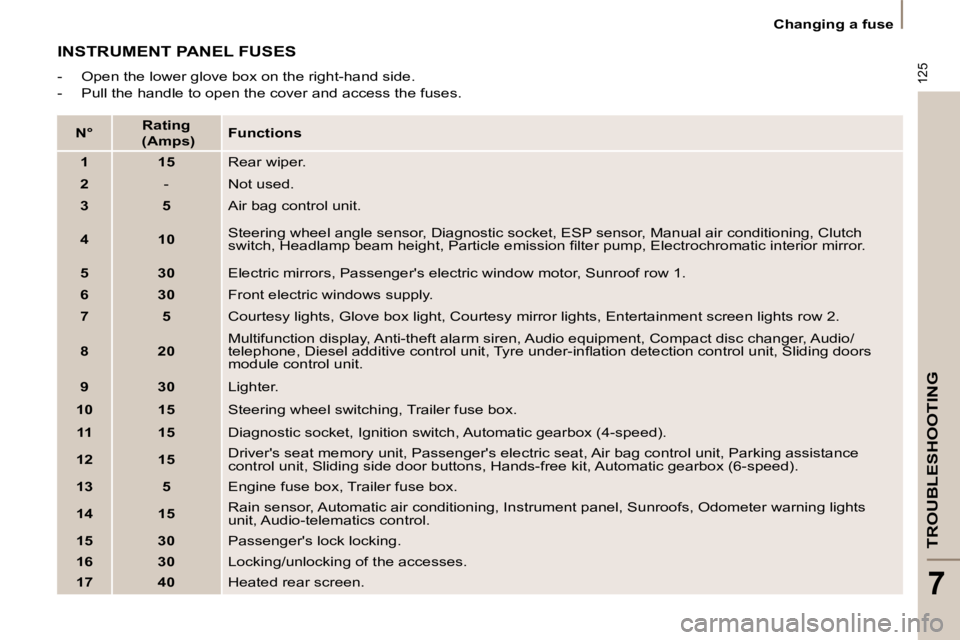
125
TROUBLESHOOTING
7
Changing a fuse
INSTRUMENT PANEL FUSES
� � � �-� � �O�p�e�n� �t�h�e� �l�o�w�e�r� �g�l�o�v�e� �b�o�x� �o�n� �t�h�e� �r�i�g�h�t�-�h�a�n�d� �s�i�d�e�.�
- Pull the handle to open the cover and access the fuses.
N°
Rating
(Amps)
Functions
1 15 Rear wiper.
2 - Not used.
3 5 Air bag control unit.
4 10 Steering wheel angle sensor, Diagnostic socket, ESP sensor, Manu
al air conditioning, Clutch
�s�w�i�t�c�h�,� �H�e�a�d�l�a�m�p� �b�e�a�m� �h�e�i�g�h�t�,� �P�a�r�t�i�c�l�e� �e�m�i�s�s�i�o�n� �fi� �l�t�e�r� �p�u�m�p�,� �E�l�e �c�t�r�o�c�h�r�o�m�a�t�i�c� �i�n�t�e�r�i�o�r� �m�i�r�r�o�r�.�
5 30 Electric mirrors, Passenger's electric window motor, Sunroof row 1.
6 30 Front electric windows supply.
7 5 � �C�o�u�r�t�e�s�y� �l�i�g�h�t�s�,� �G�l�o�v�e� �b�o�x� �l�i�g�h�t�,� �C�o�u�r�t�e�s�y� �m�i�r�r�o�r� �l�i�g�h�t�s�,� �E�n�t�e�r�t�a�i �n�m�e�n�t� �s�c�r�e�e�n� �l�i�g�h�t�s� �r�o�w� �2�.�
8 20 Multifunction display, Anti-theft alarm siren, Audio equipmen
t, Compact disc changer, Audio/
�t�e�l�e�p�h�o�n�e�,� �D�i�e�s�e�l� �a�d�d�i�t�i�v�e� �c�o�n�t�r�o�l� �u�n�i�t�,� �T�y�r�e� �u�n�d�e�r�-�i�n�fl� �a�t�i �o�n� �d�e�t�e�c�t�i�o�n� �c�o�n�t�r�o�l� �u�n�i�t�,� �S�l�i�d�i�n�g� �d�o�o�r�s�
module control unit.
9 30 Lighter.
10 15 � �S�t�e�e�r�i�n�g� �w�h�e�e�l� �s�w�i�t�c�h�i�n�g�,� �T�r�a�i�l�e�r� �f�u�s�e� �b�o�x�.�
11 15 � �D�i�a�g�n�o�s�t�i�c� �s�o�c�k�e�t�,� �I�g�n�i�t�i�o�n� �s�w�i�t�c�h�,� �A�u�t�o�m�a�t�i�c� �g�e�a�r�b�o�x� �(�4�-�s�p�e�e�d�)�.�
12 15 Driver's seat memory unit, Passenger's electric seat, Air bag control un
it, Parking assistance
�c�o�n�t�r�o�l� �u�n�i�t�,� �S�l�i�d�i�n�g� �s�i�d�e� �d�o�o�r� �b�u�t�t�o�n�s�,� �H�a�n�d�s�-�f�r�e�e� �k�i�t�,� �A�u�t�o�m�a �t�i�c� �g�e�a�r�b�o�x� �(�6�-�s�p�e�e�d�)�.�
13 5 � �E�n�g�i�n�e� �f�u�s�e� �b�o�x�,� �T�r�a�i�l�e�r� �f�u�s�e� �b�o�x�.�
14 15 Rain sensor, Automatic air conditioning, Instrument panel, Su
nroofs, Odometer warning lights
unit, Audio-telematics control.
15 30 Passenger's lock locking.
16 30 Locking/unlocking of the accesses.
17 40 Heated rear screen.
Page 131 of 237

128
Changing a fuse
Fuse box
To access the fuses located in the
engine compartment (to the left of the
coolant reservoir):
- unclip the cover.
ENGINE COMPARTMENT
FUSES
The designations communicated
only relate to the fuses which can
be changed by the user using
the pliers and spare fuses, located in
�t�h�e� �g�l�o�v�e� �b�o�x� �b�e�h�i�n�d� �t�h�e� �i�n�s�t�r�u�m�e�n�t�
�p�a�n�e�l� �f�u�s�e� �b�o�x�,� �o�n� �t�h�e� �r�i�g�h�t�-�h�a�n�d� �s�i�d�e�.�
For any other work, visit a PEUGEOT
dealer.
Carefully close the cover when you
�h�a�v�e� �fi� �n�i�s�h�e�d�.
The electrical system of your vehicle is
designed to operate with standard or
optional equipment.
Before installing other electrical
equipment or accessories on your
vehicle, consult a PEUGEOT dealer.
PEUGEOT will not accept
responsibility for the cost incurred in
repairing your vehicle or for rectifying
the malfunctions resulting from the
installation of accessories not supplied
and not recommended by PEUGEOT
and not installed in accordance with
its instructions, in particular where the
equipment in question consumes more
than 10 milliamperes. Intended for professionals: for full
fuse and relay information, consult the
"Methods" diagram via the PEUGEOT
network.